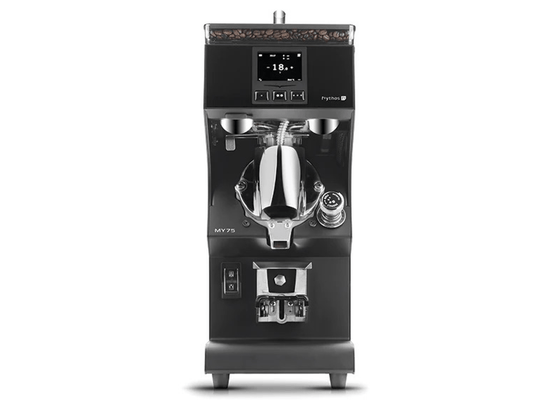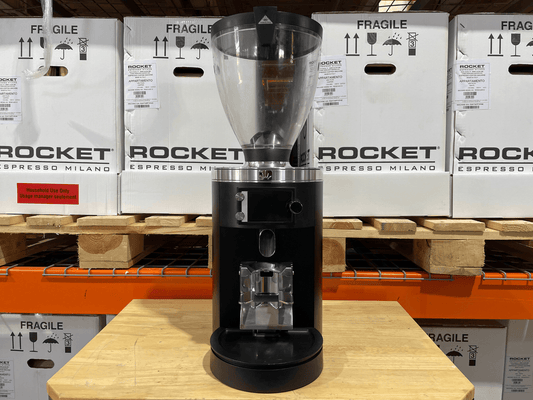SHOP BY machine TYPE
SHOP BY boiler type

Your wishlist is empty.
Explore Our Handpicked Coffee Equipment -
for Home | for Commercial
Get Monthly Offers & Discounts - 5% off Now
Sign Me Up
SHOP BY machine TYPE
SHOP BY boiler type

Espresso machines
SHOP BY machine TYPE
SHOP BY boiler type
Renewed Machines
SHOP BY machine TYPE
SHOP BY boiler type
Accessories
Best Bundles
Fast Shipping
Espresso machines
Accessories
Best Bundles
Fast Shipping
Commercial Coffee grinders use tw burrs (Steel with sharp teeth-like grooves) to break down whole bean coffee into tiny particles. One of these burrs is driven by a large synchronous AC AC motor, capable of rotating the burr at high speeds (revolutions per minute / RPM). The other burr is stationary.
What’s special is the speed, consistency and durability. Today’s grinders can grind large doses on demand in just a few seconds. They can do this while maintaining excellent grind uniformity. Unlike less expensive home grinders, commercial grinder motors and cases are exceptionally durable, capable of lasting many years of abuse.
Burr Grinders: Commercial coffee grinders typically use burrs rather than blades to grind the coffee beans. Burrs are two abrasive surfaces that crush the beans into uniform particles. They offer more precise and consistent grinding results compared to blade grinders. There are 2 types: flat burrs and conical burrs.
Fine or coarse: Commercial grinders typically fall into two categories: Those that can grind coffee down into fine particles and those that grind coffee down into coarser particles. Espresso grinders have specially suited burrs that grind on the finer end of the spectrum, whereas drip coffee grinders (also referred to as batch, shop, or bulk grinders) have burr sets designed for producing coarser coffee grounds.
Consistency: Commercial espresso grinders are designed to produce consistent grind sizes, which is crucial for extracting the optimal flavor from coffee. To grind faster and more consistently, commercial coffee grinders have burr sizes of at least 60mm. The consistency ensures that the particles have a similar size, leading to even extraction during brewing.
Adjustable Grind Settings: Most commercial coffee grinders allow users to adjust the grind size to suit different brewing methods. Espresso grinders are designed to grind on the finer-end of the spectrum and are only capable of grinding espresso and Turkish coffee. Drip coffee makers, often referred to as shop, bulk or batch brew coffee grinders are capable of making drip coffee, french press, pour overs, cold brew or really anything that requires a coarser grind. This flexibility enables baristas to customize the grind according to the coffee's desired strength and extraction requirements.
Capacity and Speed: Commercial grinders are built to handle high volumes of coffee beans. They have larger hoppers to hold more beans and powerful motors to grind them quickly. The capacity and speed of commercial grinders make them efficient for busy environments with an influx of customers.
Durability and Construction: Commercial coffee grinders are built to withstand heavy use and are constructed using robust materials like stainless steel or cast aluminum. They are normally built with AC asynchronous motors that are capable of grinding at a high RPM and can grind for longer periods of time versus home grinders that utilize DC motors.
Noise and Heat: Due to their powerful motors, commercial grinders can be noisy during operation. Additionally, the grinding process generates heat, which can affect the flavor of the coffee. To mitigate this, some higher-end models incorporate features like noise reduction technology and cooling systems to maintain consistent grind quality.
Cost: Commercial coffee grinders can range in price depending on their features, size, and brand. Generally, they are more expensive than home coffee grinders due to their enhanced durability, higher capacity, and professional-grade components.
Cleaning a commercial coffee grinder is essential to maintain its performance, prevent flavor contamination, and ensure the longevity of the machine. Here is a general guide on how to clean a commercial coffee grinder:
Safety First: Before cleaning, ensure that the grinder is unplugged and turned off to prevent any accidents.
Empty the Hopper: Remove any remaining coffee beans from the hopper. You can either use them or discard them if they are stale.
Disassemble Removable Parts: If your grinder has removable parts, such as the hopper, grind chamber, or burrs, carefully detach them according to the manufacturer's instructions. Consult the grinder's manual for specific disassembly steps.
Brush Out Coffee Residue: Use a brush with stiff bristles, such as a grinder brush or a small paintbrush, to clean out any coffee grounds or residue from the grinder's hopper, grind chamber, and chute. Brush away any debris from the burrs as well.
Vacuum or Air Blast: To remove finer coffee particles and dust, you can use a small handheld vacuum or an air compressor to blow air into the grinder's components. Be cautious not to damage any delicate parts during this process.
Clean Removable Parts: If you have removed any components, wash them with warm water and mild dish soap. Ensure they are thoroughly rinsed and dried before reassembling them back onto the grinder.
Clean Burrs: Burrs can be cleaned more thoroughly by using a dedicated burr cleaning product or a mixture of rice and mild soap. Follow the manufacturer's instructions for cleaning the burrs, as the process may vary depending on the grinder model.
Remember to always refer to the specific instructions provided by the grinder's manufacturer, as different grinders may have unique cleaning requirements.
Usually ships within 5 business days
F64 E Dark-T (Open Box)
Fiorenzato
Usually ships within 2-3 business days
Usually ships within 2-3 business days
E80W GbS (Open Box)
Mahlkonig
Usually ships within 2-3 business days
Usually ships within 2-3 business days
EK43S (Open Box)
Mahlkonig
Usually ships within 2-3 business days
E80S /E80T Black (Demo)
Mahlkonig
Usually ships within 2-3 business days
F83 E Sense Dark-T (Open Box)
Fiorenzato
Usually ships within 2-3 business days
Commercial Coffee grinders use tw burrs (Steel with sharp teeth-like grooves) to break down whole bean coffee into tiny particles. One of these burrs is driven by a large synchronous AC AC motor, capable of rotating the burr at high speeds (revolutions per minute / RPM). The other burr is stationary.
What’s special is the speed, consistency and durability. Today’s grinders can grind large doses on demand in just a few seconds. They can do this while maintaining excellent grind uniformity. Unlike less expensive home grinders, commercial grinder motors and cases are exceptionally durable, capable of lasting many years of abuse.
Burr Grinders: Commercial coffee grinders typically use burrs rather than blades to grind the coffee beans. Burrs are two abrasive surfaces that crush the beans into uniform particles. They offer more precise and consistent grinding results compared to blade grinders. There are 2 types: flat burrs and conical burrs.
Fine or coarse: Commercial grinders typically fall into two categories: Those that can grind coffee down into fine particles and those that grind coffee down into coarser particles. Espresso grinders have specially suited burrs that grind on the finer end of the spectrum, whereas drip coffee grinders (also referred to as batch, shop, or bulk grinders) have burr sets designed for producing coarser coffee grounds.
Consistency: Commercial espresso grinders are designed to produce consistent grind sizes, which is crucial for extracting the optimal flavor from coffee. To grind faster and more consistently, commercial coffee grinders have burr sizes of at least 60mm. The consistency ensures that the particles have a similar size, leading to even extraction during brewing.
Adjustable Grind Settings: Most commercial coffee grinders allow users to adjust the grind size to suit different brewing methods. Espresso grinders are designed to grind on the finer-end of the spectrum and are only capable of grinding espresso and Turkish coffee. Drip coffee makers, often referred to as shop, bulk or batch brew coffee grinders are capable of making drip coffee, french press, pour overs, cold brew or really anything that requires a coarser grind. This flexibility enables baristas to customize the grind according to the coffee's desired strength and extraction requirements.
Capacity and Speed: Commercial grinders are built to handle high volumes of coffee beans. They have larger hoppers to hold more beans and powerful motors to grind them quickly. The capacity and speed of commercial grinders make them efficient for busy environments with an influx of customers.
Durability and Construction: Commercial coffee grinders are built to withstand heavy use and are constructed using robust materials like stainless steel or cast aluminum. They are normally built with AC asynchronous motors that are capable of grinding at a high RPM and can grind for longer periods of time versus home grinders that utilize DC motors.
Noise and Heat: Due to their powerful motors, commercial grinders can be noisy during operation. Additionally, the grinding process generates heat, which can affect the flavor of the coffee. To mitigate this, some higher-end models incorporate features like noise reduction technology and cooling systems to maintain consistent grind quality.
Cost: Commercial coffee grinders can range in price depending on their features, size, and brand. Generally, they are more expensive than home coffee grinders due to their enhanced durability, higher capacity, and professional-grade components.
Cleaning a commercial coffee grinder is essential to maintain its performance, prevent flavor contamination, and ensure the longevity of the machine. Here is a general guide on how to clean a commercial coffee grinder:
Safety First: Before cleaning, ensure that the grinder is unplugged and turned off to prevent any accidents.
Empty the Hopper: Remove any remaining coffee beans from the hopper. You can either use them or discard them if they are stale.
Disassemble Removable Parts: If your grinder has removable parts, such as the hopper, grind chamber, or burrs, carefully detach them according to the manufacturer's instructions. Consult the grinder's manual for specific disassembly steps.
Brush Out Coffee Residue: Use a brush with stiff bristles, such as a grinder brush or a small paintbrush, to clean out any coffee grounds or residue from the grinder's hopper, grind chamber, and chute. Brush away any debris from the burrs as well.
Vacuum or Air Blast: To remove finer coffee particles and dust, you can use a small handheld vacuum or an air compressor to blow air into the grinder's components. Be cautious not to damage any delicate parts during this process.
Clean Removable Parts: If you have removed any components, wash them with warm water and mild dish soap. Ensure they are thoroughly rinsed and dried before reassembling them back onto the grinder.
Clean Burrs: Burrs can be cleaned more thoroughly by using a dedicated burr cleaning product or a mixture of rice and mild soap. Follow the manufacturer's instructions for cleaning the burrs, as the process may vary depending on the grinder model.
Remember to always refer to the specific instructions provided by the grinder's manufacturer, as different grinders may have unique cleaning requirements.
Sign up and get 5% off first order
Sign up for our newsletter to keep up with new products, events and 5% off your first order!









